‘Back to the kitchen table’ Chandra Erlendson sources memory and family in reclamation cooking project
Read this article for free:
or
Already have an account? Log in here »
To continue reading, please subscribe:
Monthly Digital Subscription
$0 for the first 4 weeks*
- Enjoy unlimited reading on winnipegfreepress.com
- Read the E-Edition, our digital replica newspaper
- Access News Break, our award-winning app
- Play interactive puzzles
*No charge for 4 weeks then price increases to the regular rate of $19.00 plus GST every four weeks. Offer available to new and qualified returning subscribers only. Cancel any time.
Monthly Digital Subscription
$4.75/week*
- Enjoy unlimited reading on winnipegfreepress.com
- Read the E-Edition, our digital replica newspaper
- Access News Break, our award-winning app
- Play interactive puzzles
*Billed as $19 plus GST every four weeks. Cancel any time.
To continue reading, please subscribe:
Add Free Press access to your Brandon Sun subscription for only an additional
$1 for the first 4 weeks*
*Your next subscription payment will increase by $1.00 and you will be charged $16.99 plus GST for four weeks. After four weeks, your payment will increase to $23.99 plus GST every four weeks.
Read unlimited articles for free today:
or
Already have an account? Log in here »
Hey there, time traveller!
This article was published 11/04/2023 (972 days ago), so information in it may no longer be current.
Kitchen-table conversations have always played an important role in Chandra Erlendson’s life.
Growing up, mealtime was a chance to engage in thought-provoking talk.
Homemade: Downtown Edition

It is often the simplest of foods that evoke the strongest of emotions. That first cup of tea as dawn breaks, standing still before life comes crowding in. The perfumed sweetness of a fuzzy peach. A grilled cheese scarfed down in a rush between activities, leaving your tongue slightly burned. The smell of buttery popcorn, salty on lips as you lean in for a first kiss at the cinema.
It is often the simplest of foods that evoke the strongest of emotions. That first cup of tea as dawn breaks, standing still before life comes crowding in. The perfumed sweetness of a fuzzy peach. A grilled cheese scarfed down in a rush between activities, leaving your tongue slightly burned. The smell of buttery popcorn, salty on lips as you lean in for a first kiss at the cinema.
Homemade: Downtown Edition is a monthly series inviting a person who works in Winnipeg’s downtown to cook and talk about their favourite comfort food.
If we are what we eat, then who are you?
This series would not have been possible without the generosity of staff at RRC Polytech, Paterson GlobalFoods Institute, who kindly permitted us to use the kitchens of Jane’s restaurant.
While breaking bread with kith and kin, Erlendson gained a deeper understanding of how the people she was closest to experience the world, and how their views differed from her own.
She still finds the dinner table one of the best places to tackle difficult discussions. For her, it’s a safe space to argue and debate, to disagree and eventually — hopefully — come together in mutual understanding.
The lessons she’s learned at the table are ones she brings with her in her role as the director of Indigenous Relations and Community Engagement at the Canadian Museum for Human Rights.
Previously the museum’s manager of public programs, Erlendson, 52, now focuses on building representation in the museum, working with elders to bring Indigenous perspectives to the table in a “more integrated and formalized manner.”
As a Métis woman, she feels her role at CMHR is reflective of her culture and her family.
“I think representation is key to making people feel like they belong,” she says. “Underrepresented folks need to be part of the decision-making.”
Ultimately for Erlendson, any sort of meaningful adjustment can only take place when people find themselves comfortable enough to safely speak their truths. She leans back on the inter-generational setting in which she was raised, the fertile ground that helped provoke thought and foster dialogue.
JESSICA LEE / WINNIPEG FREE PRESS Chandra Erlendson's reclamation cooking involves gathering ingredients, including venison caught by her children, as well as family recollections.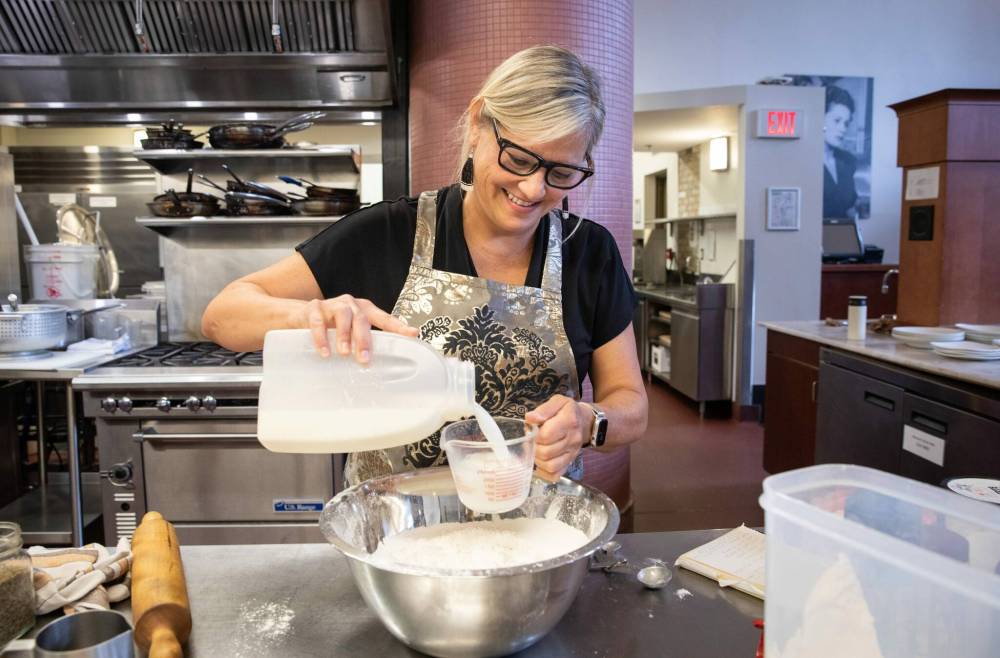
“When we are creating programs, we talk about really difficult issues. Everybody has a different way of understanding or a different level of interest of certain rights or not even have any knowledge, in certain ways, of certain topics. How do you manage all that?
“My go-to is always back to that kitchen table. That is the entry point… into all these relationships: what do I expect, what do they need to know, what do they expect, how do they want to feel?
“My entry point is through my heart. All I do is through my heart.”
Born in Winnipeg in December 1970 to Irene Marie Brown and James Alexander Brown, Erlendson spent the first year of her life living with her maternal grandparents in Cayer, before moving to Winnipeg with her parents in the fall of 1971.
As a child, she and her brother Derek moved all over the country, due to her father’s job at PCL Construction. Holidays were always spent back in Cayer, a tiny town in central Manitoba just west of Lake Manitoba, where her grandparents owned the general store. There they would join up with their large extended family — Erlendson has more than 50 cousins on her mother’s side — and the children would mess about together throughout the holidays.
JESSICA LEE / WINNIPEG FREE PRESS "I am doing a bit of storytelling, using our recipes as a way to get some of the younger generation aware of where we come from," Erlendson says.
“My parents would send us on a Grey Goose bus that would take us on Highway 6 up to Highway 68 that would bring us to this gas station where my grandfather would be waiting to pick us up.
“It would be just us two kids by ourselves; we would have snacks for the bus and some money to get snacks wherever the bus driver would be able to stop. More often than not it would be Lundar where we would get out and get a chip and drink, that’s what we used to call it.”
She was close to her maternal grandmother, whom she refers to as Mémère Métisse, and remembers eating in the Cayer kitchen, family members cooking together to create gargantuan meals.
Her mémère would often make fry bread, cooking it in lard because it was too expensive to use oil back then.
“They always had lard in the kitchen from everything they cooked. There was a pail underneath the kitchen sink and they would pull it out when they were cooking and it was lard on top of lard. We would scrape all that — there was a lard collector — and we would reuse it. There was a lot of flavour to it from all the different meats.”
“That was my first experience of farm to table… I mean just minutes before I had been playing with it and now I had to eat that chicken.”–Chandra Erlendson
Nowadays, when she and her cousins try to re-create their childhood dishes, nothing ever tastes quite like their grandmother’s food.
“It’s because of the lard!” she says with a laugh.
Her most vivid childhood memory involves an accidental killing that took place during March break, on a wet spring day when a group of cousins were playing in her grandmother’s chicken coop, which was housed in a hollowed-out old Honda Civic.
The children had been forbidden from entering, but the temptation proved too great.
“There was a gaggle of us inside the coop. We heard my mémère coming, and we had to get out. I got all the little children out… then one little chicken popped its head out and I caught its head, and I killed it,” she recalls.
JESSICA LEE / WINNIPEG FREE PRESS Chandra Erlendson hopes a collection of recipes and family stories will inspire younger members of the family to gain a deeper understanding of their roots.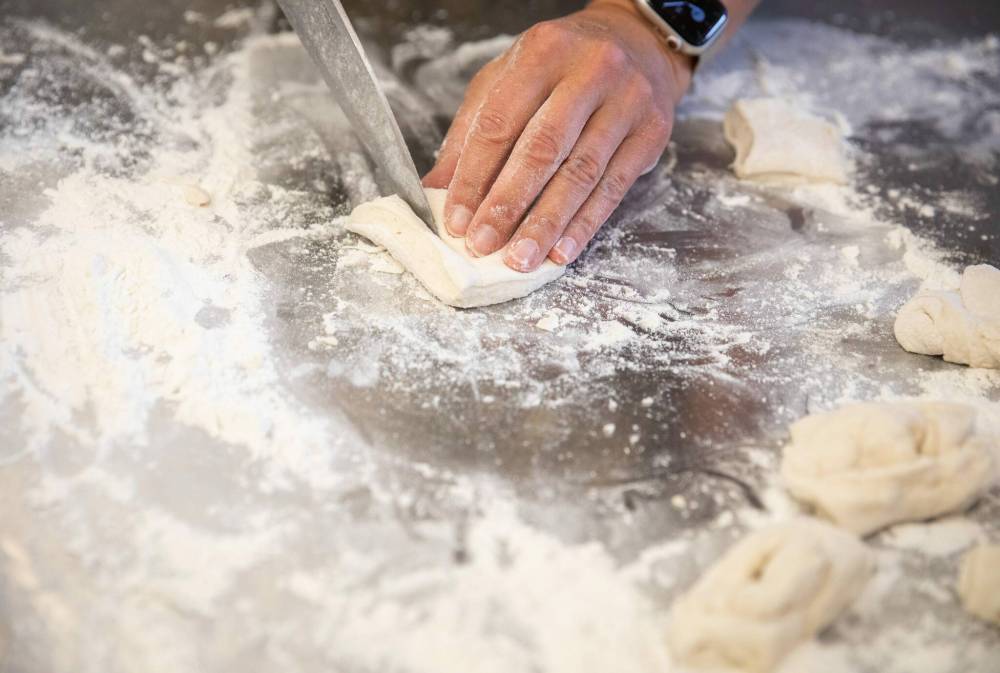
There was nothing to do other than own up.
“I go back in and confess. My mémère doesn’t say a thing but she puts on her big galoshes, she goes out there and grabs the dead chicken, takes her hatchet, and cuts off the head and feet, bleeds it and plucks it, then throws it into the roaster.
“That was my first experience of farm to table… I mean just minutes before I had been playing with it and now I had to eat that chicken,” Erlendson recalls. The incident reinforced her awareness of where meat comes from.
While she personally hasn’t had a hand in the sourcing of the meat for today’s meal — venison stew (jumper meat) and bangs (fry bread) — members of her family have.
JESSICA LEE / WINNIPEG FREE PRESS "The key to keep them twisty," Chandra Erlendson says about Métis fry bread, "is a lot of flour, so they don’t stick."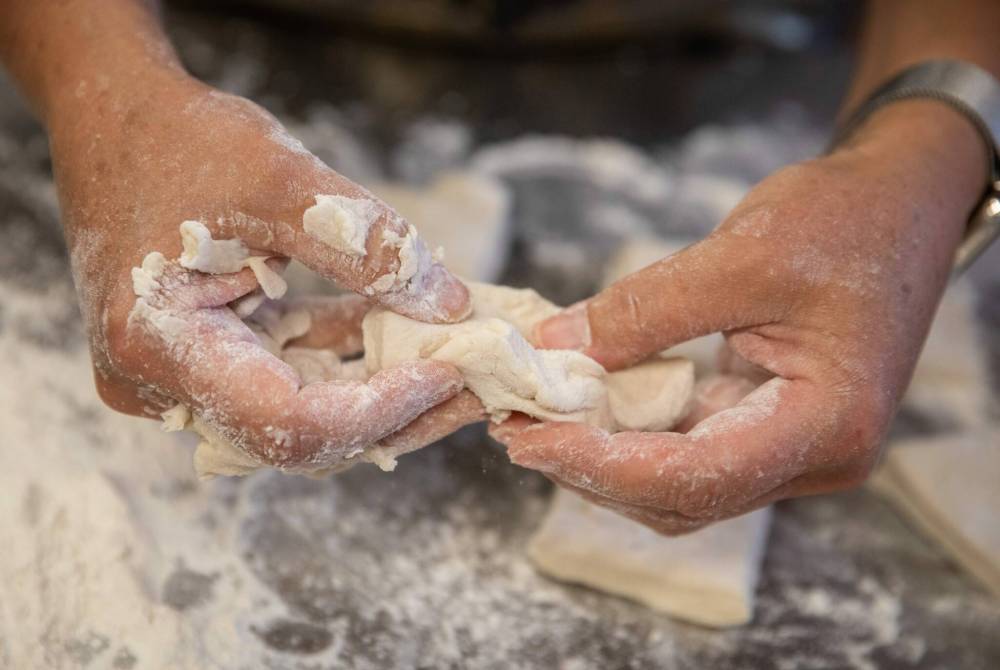
The venison is from a batch her children brought back from their hunt in November. All that’s left now are the cuts best used for slow-cooking, well seasoned and perfect for this stew.
It’s a meal she grew up on, one that’s considered survival food. There are family members who won’t eat it anymore because they ate it so much growing up, she says.
“It’s absolutely delicious and very comforting because it bring us back to our stories and our history and our traditions. I have never eaten it without someone in our family talking about a hunting story.
“The thing about this bread is… this is what makes it Métis fry bread, this is our bread; it’s got a twist that comes out. Twisting the bread, it looks messy but you will see how beautiful they are,” she explains as she deftly manipulates the dough. “The key to keep them twisty is a lot of flour, so they don’t stick.”
Erlendson’s children — Dylan, 33, Chloe, 31 and Rane, 28 — make their “autumn pilgrimage” every year to Cayer to hunt deer on their grandparents’ land. They and other family members head out to the bush for 10 days, gutting and bleeding the deer on the land before Dylan butchers it.
JESSICA LEE / WINNIPEG FREE PRESS Chandra Erlendson prepares dough for Métis fry bread. She describes sharing the recipes as reclamation cooking — reviving the meals of her Métis family that might otherwise be lost.
Every single bit of the animal is used: hides are hung and shared among cousins who have joined the hunt; bones are used to make broth; heads are cleaned and mounted.
Erlendson is currently working on a Métis cookbook with Chloe, compiling all her family’s stories and memories to run alongside the recipes. They are in the process of identifying potential Indigenous-led publishers.
She describes it as reclamation cooking — reviving the meals of her Métis family that might otherwise be lost.
Before embarking on the project, she consulted one of her mother’s older brothers to ensure he and other members of the family were supportive of the idea. The revealing of shared memories requires consent, she says. The family members all love the idea and the cousins have been reminding her of dishes their grandmother used to make, such as mustard beans and saskatoon jam.
“I talked to my Uncle Daniel, one of my mum’s older brothers who is a very good historian; he is our elder now. You have to be respectful if you are sharing stories of your family.”
JESSICA LEE / WINNIPEG FREE PRESS Once you get to the frying phase, be prepared to act quickly!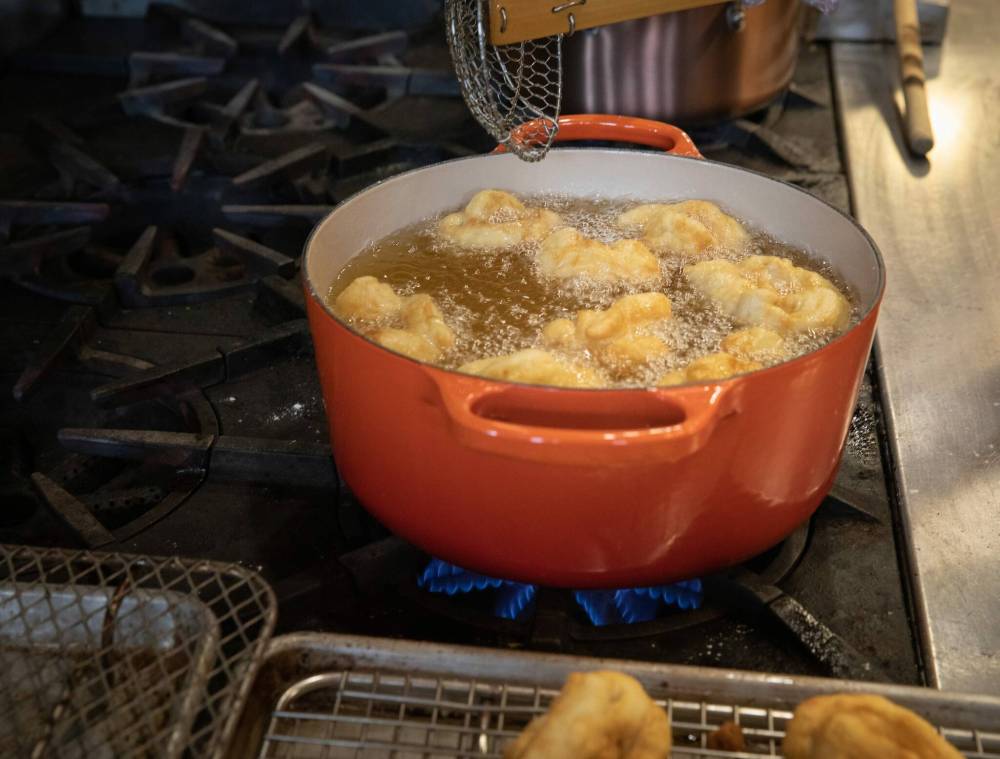
She hopes the book will inspire younger members of the family to gain a deeper understanding of their roots.
“I am doing a bit of storytelling, using our recipes as a way to get some of the younger generation aware of where we come from. It will be something fun for them to have and they will feel a connection, because it’s our grandmother’s recipes and our great-grandmother’s recipes.
“This isn’t just my grandmother’s; these are from our foremothers. I couldn’t care less if the book sells. It really is for my family. It makes me emotional to think about it.”
av.kitching@winnipegfreepress.com
Venison (Jumper) Stew
Prep time 30 mins
Cook time 1.5-2 hours
Feeds up to 6 people
JESSICA LEE / WINNIPEG FREE PRESS Chandra Erlandson’s venison stew with Métis fry bread.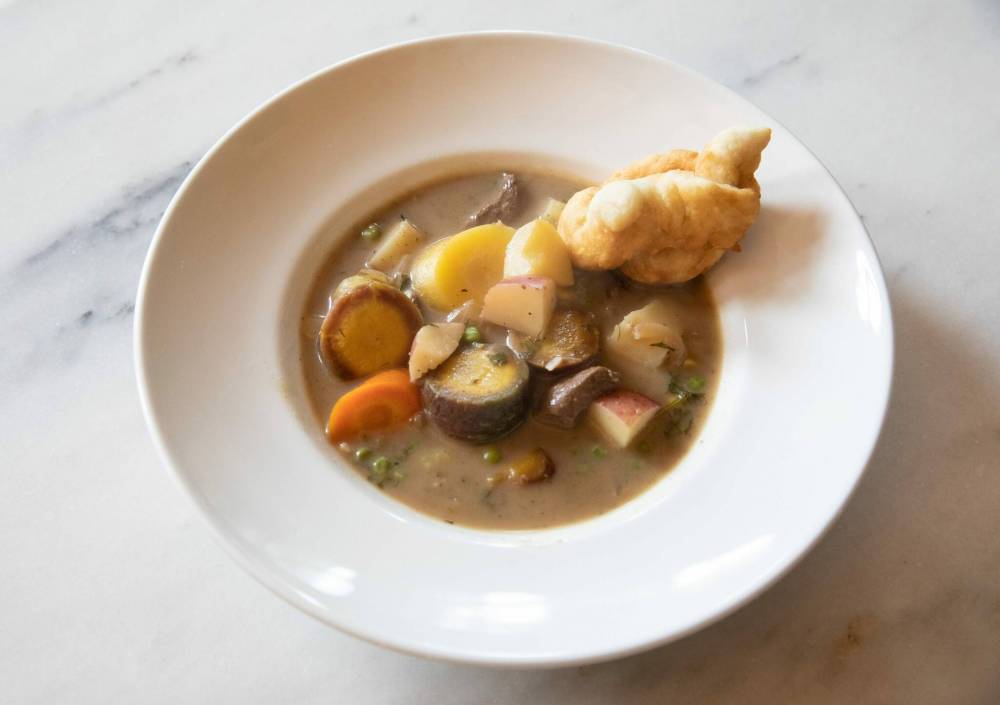
680 g to 1.35 kg (1.5-3 lbs) of a small deer roast, cubed into small pieces
2-3 fresh cloves of garlic minced (use as much or as little as you like)
1 medium to large yellow onion, diced
Healthy pinch of salt at the beginning and end to taste
5 ml (1 tsp) each of dried oregano, thyme, and rosemary
80 ml (1/3 cup) water, set aside
Bay leaf
15 ml (1 tbsp) butter
1 swirl of oil (any kind)
3-4 rounds of coarsely cracked pepper (mill)
6 medium yellow-fleshed potatoes, cut into four spears then cut in half
4 large carrots, thickly sliced
250 ml (1 cup) fresh or frozen sweet peas (not canned)
750 ml (3 cups) of beef stock or venison bone broth
750 ml (3 cups) water
80 ml (1/3 cup) flour or 30 ml (2 tbsp) cornstarch in a cup for thickening the stew, add very cold water to make a pasty roux
In a Dutch oven brown meat with swirl of oil, salt and pepper to start, adding minced garlic, onions and herbs.
Start on high heat with meat and oil then reduce the heat to half as you add the herbs and spices.
Keep low and sweat the pot by placing the lid on top for five minutes. Peek to be sure there is liquid forming and gradually add a 1/3 cup of water.
Let simmer for another five minutes. It should smell heavenly. Stew on very low simmer, covered, for 15 minutes.
Once the meat is properly seasoned, and stewed and tender, add in all the vegetables, (except the peas), to the meat mixture. Add bay leaf and butter, water and stock and more salt and pepper. Bring to a rolling boil. Once it comes to a boil, reduce to simmer for 30 minutes, covered.
After 30 minutes add fresh or frozen peas, then the flour or cornstarch mixture, stir gently (potatoes are delicate), taste, taste, taste, and add more herbs, or salt and pepper, or stock accordingly.
Stew on low for another 30 minutes. Serve topped with fresh snipped thyme or dill.
If you like your stew thicker, add in a little more flour or cornstarch mix. Otherwise know that it continues to thicken during the last stew time.
Bangs (Métis Fry Bread)
Prep time 30 mins
Cook time 30 mins
Makes about 10 dozen
JESSICA LEE / WINNIPEG FREE PRESS "Twisting the bread, it looks messy but you will see how beautiful they are," Chandra Erlendson says of her family's fry bread.
1.5 litres (6 cups) of flour
1 litre (4 cups) warm milk
37 ml (2 1/2 tbsp) baking powder
10 ml (2 tsp) salt
30 ml (2 tbsp) shortening (lard) or oil
3 litres (12 1/2 cups) canola or vegetable oil
Fill Dutch oven with all the oil and begin to heat on medium-high. Be careful. You want the oil very hot but not on high! The temperature will lower slightly as you begin to drop in your bangs. Have a metal rack ready beside the stove top along with paper towels or a tea towel under the metal rack to catch the oil that drips off the bangs. Also have a metal mesh scoop for turning and lifting the bangs out of the oil onto the rack to cool.
Mix the dry ingredients together then slowly add the wet while gently kneading and folding. Keep a little flour to the side to add when it becomes very sticky and wet. Eventually you will form a soft pillowy dough. Takes only a few minutes to do this first step.
Flour your counter generously, then place the dough and pat down with your hands first to spread it out. It will be misshaped at first.
With a floured rolling pin, gently roll out dough to a 1/4-inch thickness. You may need to cut your dough in half if your counter is too small.
Use a knife to cut the rolled dough into 3-inch strips, then cut the 3-inch strips into 3-inch pieces — basically squares. Keep them lightly floured to prevent from sticking to the counter or your fingers. You need to pick up each square.
Cut two short slits into the dough square and pick up gently with your fingers, allowing for the slits to part so you get a nice twist and fold. Repeat with the rolled out dough so you have a pile of little dough squares that are 3 inches by 3 inches, 1/4 inch thick.
While you have been doing the dough, the oil has been heating. Do a test bang to see if your oil is up to the proper cooking temperature: a small cast of dough dropped into the pot of oil should bubble up right away, brown almost instantly and come to the top — turn it within seconds of dropping. It should also puff up! Remove with a mesh scoop and let cool.
Try it. Taste it. If it is cooked, you know the timing and that your oil is ready. You may need to test a couple to get it just right. Once you are ready to go, drop the twisted little bangs into the hot oil — slowly and gently — up to 10 at a time.
It is quick and you need to be at the oil the entire time — no turning away. You need to flip the little bangs in the oil within seconds of dropping. They turn golden brown before your eyes. It’s instant. Pull them out one or two at a time carefully and drop onto the rack. Repeat this until all the bangs are fried.
Enjoy!
These freeze well in baggies (after completely cooling).

AV Kitching is an arts and life writer at the Free Press. She has been a journalist for more than two decades and has worked across three continents writing about people, travel, food, and fashion. Read more about AV.
Every piece of reporting AV produces is reviewed by an editing team before it is posted online or published in print — part of the Free Press‘s tradition, since 1872, of producing reliable independent journalism. Read more about Free Press’s history and mandate, and learn how our newsroom operates.
Our newsroom depends on a growing audience of readers to power our journalism. If you are not a paid reader, please consider becoming a subscriber.
Our newsroom depends on its audience of readers to power our journalism. Thank you for your support.
History
Updated on Thursday, April 13, 2023 1:25 PM CDT: Corrects highway directions, removes trap line reference.











